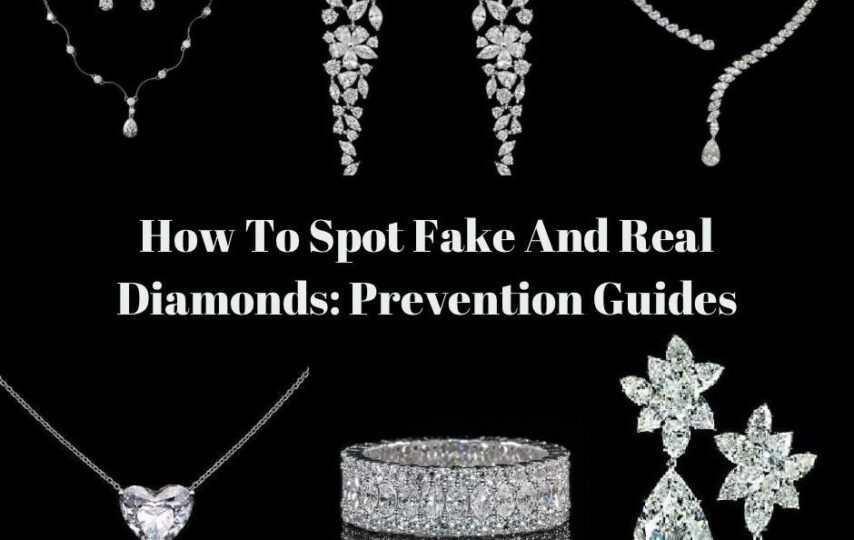If you aren’t familiar with making a diamond, you could mistake a gemstone for a diamond if somebody is trying to scam you. Unfortunately, many people online are always searching for buyers who aren’t informed well about their purchases. Buying a diamond can be one such purchase.
For example, several scammers online sell cubic zirconia or moissanite, claiming to be diamonds. The gemstone is as flawless as diamonds, less expensive, and durable enough to trick you. But it simply cannot compete with the king of gems when it comes to hardness.
Diamond scores 10 on hardness on the Mohs hardness scale, while zirconia has a hardness of 8-8.5. So, be very careful while buying diamond jewelry.
If you’re purchasing something online, you only take the seller’s word for it. So, it is relatively easy to fool someone into believing fake gemstones for diamonds.
So, how do you spot fake and real diamonds and save yourself from being scammed? This article discusses all possible ways to spot a fake and a natural diamond effectively. Continue reading to find out.
Lab Grown Diamonds – Are They Real?
In the last several years, lab grown diamonds have become a real thing. But one question several people ask is, are lab grown diamonds real Yes, they are!
Lab grown is just as real as a naturally mined diamond and is identical to the former in terms of its identity, chemical properties, and physicality. However, lab grown diamonds aren’t stimulants like moissanite or cubic zirconia. You can effectively check to make sure through the methods mentioned below.
Lab grown diamonds are capable of passing every test just like real diamonds. The only difference between natural and lab created diamonds is that they are grown in a laboratory and cost relatively less. They are also eco-friendly, which makes them worth buying.
Methods to Spot Real and Fake Diamonds
You may have purchased an engagement ring and now you’re confused about whether the diamond integrated into it is natural or not. Let our guide help you figure it out. We have enlisted several methods you can try at home to determine if your trinket is loaded with genuine diamonds or if you’ve been scammed!
- Water Drop Test
Before we complicate things for you by suggesting complex methods, here is a simple water drop test. You can try it first and see if your diamond is natural or not.
Grab a regular-sized glass and fill ¾ of it with water. Drop the loose stone in the water and see if it sinks or floats. If the stone touches the surface of your glass, then it is a natural diamond. If the stone floats, then you have a copy on your hands.
A natural diamond will possess a high density. The water shows whether the diamond matches the thickness of the water or not. If it doesn’t, then you have a fake diamond.
- Conduct a Heat Test
Now, this might sound a little dangerous, but it’s not. If you want to know the authenticity of your wedding day diamonds, you must conduct this test if the previous one didn’t satisfy your intrigue.
You can start by putting on fireproof gloves and filling the glass with cold water. Next, hold the stone with the help of a utensil and heat for 30-40 seconds. Once done, submerge the diamond immediately into the cold water.
The diamond will show little to no reaction if it’s real. If it’s fake, it will probably shatter into pieces. A gemstone like cubic zirconia isn’t capable of handling this rapid expansion and contraction of heat.
- Try the Fog Test
If you aren’t into extreme tests to verify diamonds in your diamond jewelry, here is a less intense option that you can try.
Hold your diamond between your two fingers so you can see it. Now, blow on it and see if the fog dissipates immediately. If it does, then you have a genuine diamond in your hand. On the other hand, if it takes time to disperse, the diamond you’re holding is a fake.
Diamonds are a great conductor of heat, so they should dissipate immediately. However, if the fog stays on the diamond for a few seconds, it isn’t a natural diamond.
- Take the UV Light Test
You may have come across the term fluorescence if you have been researching diamond verification for some time. Fluorescence is a phenomenon that states a natural diamond would emit a blue glow when placed right under UV light.
The intensity of the flow can vary depending on the quality of the diamond you have. You can view your diamond under UV light and see whether it emits blue light or not.
Keep in mind that not all diamonds would have this quality. So, just because your diamond isn’t emitting the blue light as it is said doesn’t necessarily mean it is fake. It’s a good test, but we don’t think it is the most conclusive.
- Test the Band
If your diamond is integrated into a piece of jewelry like a tennis bracelet or a wedding band, then perhaps you can check the piece’s quality. A jeweler will most like integrate a genuine diamond into a high-end material like platinum, white gold, or yellow gold. A jeweler wouldn’t simply attach a natural diamond to a fake trinket.
If the band of your ring or tennis bracelet is made of white gold or platinum, then chances are you’re in possession of genuine diamonds. On the other hand, if the band is a mere piece of metal, then you probably don’t have real diamonds.
- Take It to a Trustworthy Jewelry
Even after trying out all these methods, if you’re still unable to figure out whether the diamond is fake or genuine, you should take it to a jewelry store. The professionals there will check the authenticity of the diamond through various full-proof methods.
By the end, you will at least have an honest answer, and you can stop playing the guessing game. A jeweler will tell how exactly what stone it is that you possess if it’s not a diamond. The jeweler can assess its value and quality even if it is a diamond.
Final Verdict
These were some of our top methods to spot fake and natural diamonds. You should try the simplest one first before moving on to the more complicated ones. This will help you save time and effort in testing to see if your diamonds are fake.
Most of these methods do help, but they aren’t fully proven. They’re just quick tests to see if your diamond is real or not. At the end of the day, the only way to spot artificial or natural diamonds is to get a professional opinion.







